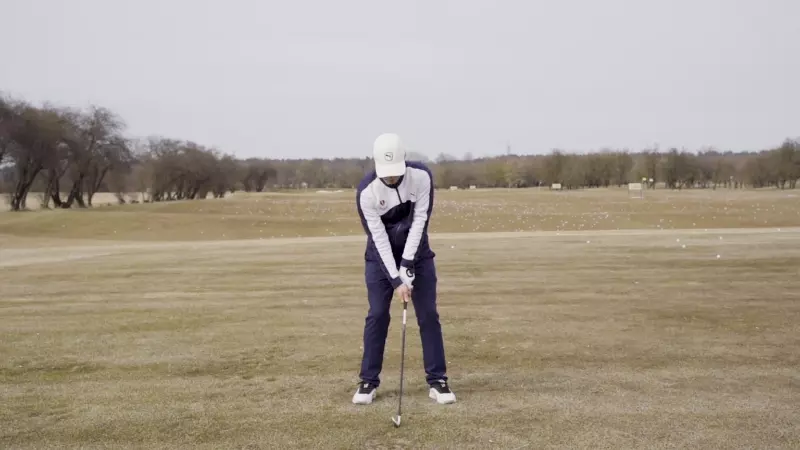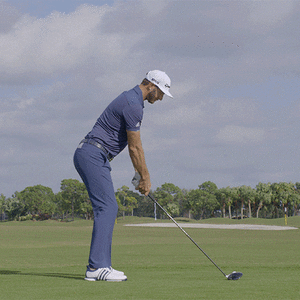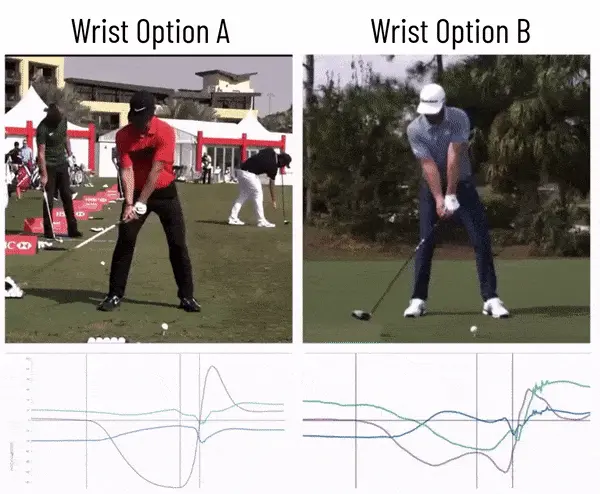When using Hackmotion, it’s important to understand the role of wrists in a golf swing and the different motion patterns that can improve wrist mechanics. There are three main wrist movements: extension/flexion (cupping/bowing), supination (forearm rotation), and radial/ulnar (hinging up and down).
Based on the analysis of over 1 million golf swings and numerous tour players, Hackmotion has identified three common patterns that great players use: Pattern A, B and C. PGA Tour Coach Scott Cowx, has categorized these patterns.
Among these patterns, Pattern A is considered the most functional for amateurs as it delivers optimal results without requiring a lot of athleticism or perfect timing. This pattern is commonly used by amateur players, making it the focus of the Hackmotion device.
Wrist Pattern A – Stable extension towards flexion, with supination – “Turn Down release”
This swing pattern has been observed in players such as Tiger Woods, Rory McIlroy, and Tommy Fleetwood. It is characterized by:
- Maintaining stable wrist extension throughout the backswing and flexing the wrist during the downswing.
- The clubhead speed is released through arm rotation, Instead of relying on extension.

Players with this pattern often favor a draw shot shape.
Players utilizing this pattern excel in wedge play, pitching, and chipping, as they demonstrate exceptional control over the club’s loft through flexion. They are adept at executing stingers and shaping shots to achieve different trajectories.
Given this information, it is highly recommended by HackMotion for amateur golfers to try and match Pattern A, which is already incorporated in the HackMotion device to offer optimal support and guidance.
Wrist Pattern B – Flexion to Extension – “Cobra pattern”
This pattern is used by players like Dustin Johnson, Collin Morikawa, Victor Hovland, and Brooks Koepka. It is almost the opposite of the stable extension pattern (Pattern A).
In pattern B, players will:
- Intentionally flex their lead wrist in the backswing (being very flexed at the top) and maintain it during the downswing.
- Release the flexion and move towards extension at impact, with minimal supination.

Players with this pattern typically play a fade shot shape and excel in hitting long shots, they are often particularly powerful drivers of the ball. However, they may struggle with pitching and chipping due to delofting the club during the backswing and needing to regain loft at impact, potentially leading to scooping and low point issues.
As players get older they have less ability to separate their upper and lower body, so it is harder for them to play with “Cobra Pattern”. It is called “cobra” because the trail arm is curled like a cobra at the top of the backswing.
Rotation of the body is key for selecting the correct pattern for the player. Players with this pattern need to be very flexible in order to be able to rotate consistently.
Wrist Pattern C – Longhitters Radial Sowncock Pattern
Unlike the common swing patterns, this particular motion pattern shares similarities with pattern A in terms of extension and flexion. However, it shows greater movement towards extension, rotation, and radial motion due to higher overtaking rates.
In pattern C, the player faces three challenges:
- Simultaneous radial increase and flexion at impact, making it a challenging movement.
- The need to adjust the club slightly at the top to manage club inertia, which tends to push the wrist toward extension.
- A release with substantial rotation is needed, involving a combination of “scoop release” and “turn down” motion. This demands impeccable timing, as the clubface undergoes significant movement during impact.
Misses with this pattern tend to result in a lower right miss and higher left miss compared to Pattern A. Players who utilize this pattern enjoy the ability to hit various trajectories and shapes of shots.
Professional golfers like Richard Jung and Robert Garrigus have embraced the distinct wrist pattern known as Pattern C in their swings. However, for the average golfer, executing this pattern presents a considerable challenge. Pattern C demands precise coordination of wrist movement in all three dimensions: extension, radial deviation, and rotation. Achieving this level of coordination is highly demanding and can make it exceptionally difficult to consistently perform Pattern C.
Choosing the Right Swing Pattern: Finding Your Ideal Wrist Mechanics
The pattern C is a rare pattern used by pros, patterns A and B are more common. The first two wrist patterns that feature the stable wrist and the flexion toward extension are quite different. But there are two similarities that we can see.
- From setup to the top of the backswing, great golfers are not adding extension. In pattern A, the wrist remains almost entirely stable; in pattern B, flexion is added.
- As golfers transition into the impact position, both of these patterns exhibit minimal extension and sometimes flexion, with similar ranges for impact. The only difference lies in the way they arrive at the impact position. With your wrist in this impact position, it’s easy to compress a golf ball and create consistent contact.

According to Scott Cowx, players may naturally lean towards a particular swing pattern, and it is crucial not to impose a specific pattern on them. The most important factor is to focus on developing consistency in their swing, regardless of their core pattern. This approach recognizes and respects the individuality of each player’s swing while emphasizing the importance of achieving a consistent and repeatable motion.
This is where Hackmotion can help. With individualized data, you can see what type of swing pattern you naturally use, and then use data to continue to refine and hone in on your swing.